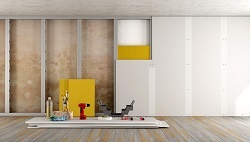
When it comes to insulating a structure, there are many things to take into consideration when deciding which type of insulation to use. It is important to consider not just your building’s composition and materials, but also climate and location. Improperly or insufficiently insulating can result in large amounts of energy loss when trying to heat and cool the structure and can also lead to mold problems when air heats and cools quickly causing moisture to form. You want to make sure you have built a healthy structure so that the occupants will remain healthy as well.
Choosing the best insulation may cost more upfront, however it will pay off in the long run, as they realize a savings in heating and cooling expenditures. It is also kinder on an HVAC system and will extend the longevity of it. For that reason, consider the insulation with the highest R-value, a rating which measures an insulation’s thermal resistance. Though higher R-values also equate to higher cost, they are denser, allowing less air to pass through, and it will be worth it in the end.
Insulation comes in a variety of forms, the most commonly used variety is the batting type, seen usually as rolls or batts, though spray foam insulation is also widely used as it is convenient and versatile. Foam board and lose fill are other insulation types as well. Two relatively recent insulation technologies are structural insulated panels (SIPs) and insulated concrete forms (ICFs). These have become popular alternatives in the green building market.
Batt and blanket insulation is composed of loosely bound fibers of fiberglass, mineral wool, denim, and other natural fibers, and is the most widely used insulation in construction. It comes in a premeasured size designed to fit between studs, or can be cut to fit an area, and is relatively easy to install.
Another option, spray foam, is made of two components that are mixed at the tip of a spray gun during application, forming a liquid foam that will expand and harden on a surface or in a particular area. This type of insulation is ideal for tight areas, such as eaves in the attic, basement crawl spaces and around pipes.
If a homeowner has chosen to build green, an alternative insulation option might be to work with structural insulated panels (SIPs) or insulated concrete forms (ICFs). Though these can be very energy efficient, they are probably not the ideal choice for everyone. SIPs are prefabricated and require precise planning and measuring and can be very costly. They are heavy, whole wall pieces made from rigid foam insulation sandwiched between two structural boards. ICF’s – or insulated concrete forms - are just that, assembled forms held together with plastic spacers and then filled with concrete. They are air tight and extremely strong and indestructible.
A final option to consider is foam boards, which work well as a thermal barrier because they are hung as one large, continuous piece. Installing foam boards effectively cuts off air circulation between your walls and living area if installed correctly, as there is no open area for the air to circulate, as it does with batt or blanket insulation. They are also highly water-resistant and come in standard 4’ x 8’ sheets. They can be hung easily, with the SCRAIL® Washer System, which allows for easy installation using a pneumatic gun.
Watch the system in action in this video.
.svg.png)

